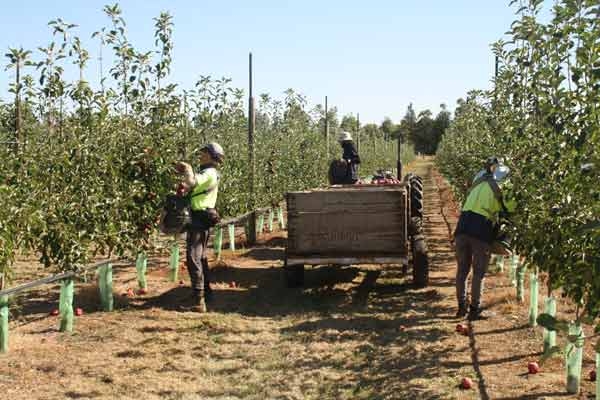The M.9 rootstock is widely used in high-density plantings of apples in many countries.
Trees on this dwarfing rootstock have shown good precocity, high tree-efficiency (a measure of yield of fruit in relation to the mass of wood), early fruit maturity, excellent fruit size, and resistance to collar rot (Phytophthora).
Fruit growers often claim that M.9 also improves the quality of the fruit. However, it is difficult to determine what effects M.9 has on fruit quality, other than yield or size of fruit.
If there is any difference, it is possibly due to more light penetration in the canopy than due to the rootstock.
If the rootstock did have an effect, it would depend very much on the variety, the locality of the orchards, and management of the trees.
M.9
M.9 was selected as a dwarfing rootstock at East Malling Research Station in 1912. M.9 was introduced to Australia in the late 1940s and continues to be popular, especially the Dutch strain 337.
Strains of M.9 have earned a reputation as outstanding rootstocks for vigorous non-spur varieties.
It is therefore not surprising, that the fruit industries and nurseries around the world encourage fruit growers to plant apple trees on M.9 at higher tree densities than before. But is this always a good move? And have all climates and soils always suited apple trees on M.9?
Careful roostock selection
A rootstock must be carefully selected to match the orchard system, the vigour of the variety, the growth potential of the climate and the soil.
There is no one best dwarfing rootstock for all climates and soils.
While many possible rootstocks are available in Australia, only a few (including M.9) are common in nurseries. However, in the USA there are at least 25 different rootstocks suitable for apple.
M.9 has a small root system but this is affected to some extent by the variety. It is possible that the small root system itself contributes to the dwarfing of the varieties—because shoot and branch length are closely related to root length.
Fruit growers choose rootstocks not only for the tree size and efficiency. Many of the dwarfing-type rootstocks popular in Europe are not adapted to the shallow topsoils, hot summers and high light intensities in apple-growing areas such as north-central Victoria and Western Australia.
An awareness of the shortcomings of M.9 could help fruit growers improve orchard performance when rootstocks are matched to prevailing climates and soils in parts of mainland Australia.
Apple orchards on M.9 in warmer areas than those in Europe, have sometimes failed to reach expected yields. Trees on the more vigorous rootstock MM.106 often produced well above that of trees on M.9.
M.9 sensitive to high soil temperatures
It is well known that M.9 is sensitive to high soil temperatures, i.e. above 25C, possibly because M.9 does not grow new roots, especially feeding roots.
In countries with long hot summers, tree vigour can be low in many apple orchards on M.9.
(continued next issue)
See this article in Tree Fruit May 2017






















